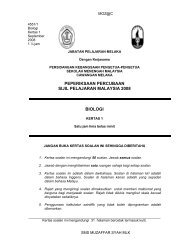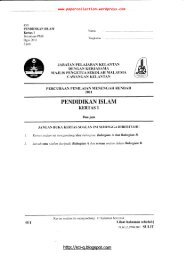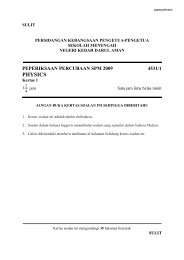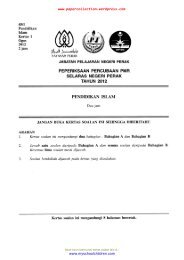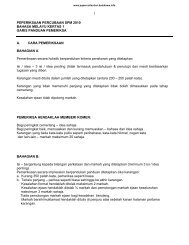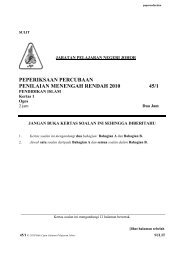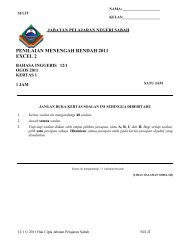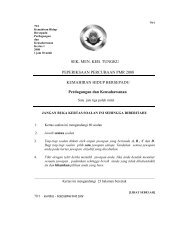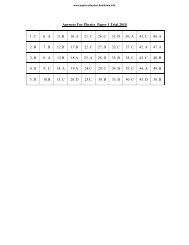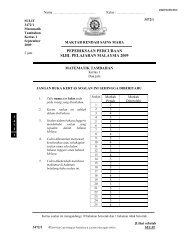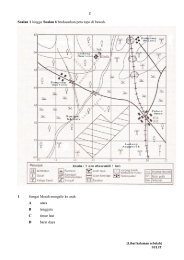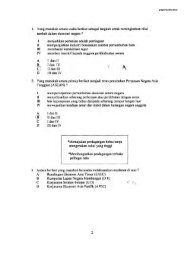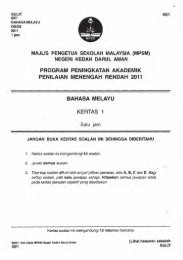TRIAL STPM 2009 CHEMISTRY PAPER 1 - Trial Paper Collection
TRIAL STPM 2009 CHEMISTRY PAPER 1 - Trial Paper Collection
TRIAL STPM 2009 CHEMISTRY PAPER 1 - Trial Paper Collection
- No tags were found...
Create successful ePaper yourself
Turn your PDF publications into a flip-book with our unique Google optimized e-Paper software.
papercollectionName : …………………………………………………NRIC : …………………………JABATAN PELAJARANTERENGGANUJABATANPELAJARAN TERENGGANUJABATANPELAJARJABATAN PELAJARANTERENGGANUJABATANPELAJARAN TERENGGANUJABATANPELAJARJABATAN PELAJARANTERENGGANUJABATANPELAJARAN TERENGGANUJABATANPELAJARJABATAN 962/1 PELAJARANTERENGGANUJABATANPELAJARAN TERENGGANUJABATANPELAJAR<strong>TRIAL</strong>JABATAN PELAJARANTERENGGANUJABATANPELAJARAN TERENGGANUJABATANPELAJAR<strong>STPM</strong> <strong>2009</strong>JABATAN PELAJARANTERENGGANUJABATANPELAJARAN TERENGGANUJABATANPELAJARJABATAN PELAJARANTERENGGANUJABATANPELAJARAN TERENGGANUJABATANPELAJARJABATAN PELAJARANTERENGGANUJABATANPELAJARAN TERENGGANUJABATANPELAJARJABATAN PELAJARANTERENGGANUJABATANPELAJARAN TERENGGANUJABATANPELAJARJABATAN PELAJARANTERENGGANUJABATANPELAJARAN JABATAN PELAJARAN TERENGGANUJABATANPELAJARJABATAN PELAJARANTERENGGANUJABATANPELAJARAN NEGERI TERENGGANUJABATANPELAJARJABATAN PELAJARANTERENGGANUJABATANPELAJARAN TERENGGANUJABATANPELAJARJABATAN PELAJARANTERENGGANUJABATANPELAJARAN TERENGGANUJABATANPELAJARJABATAN PELAJARANTERENGGANUJABATANPELAJARAN TERENGGANUJABATANPELAJARJABATAN PELAJARANTERENGGANUJABATANPELAJARAN TERENGGANUJABATANPELAJARJABATAN PELAJARANTERENGGANUJABATANPELAJARAN <strong>CHEMISTRY</strong> TERENGGANUJABATANPELAJARJABATAN PELAJARANTERENGGANUJABATANPELAJARAN <strong>PAPER</strong> 1 TERENGGANUJABATANPELAJARJABATAN PELAJARANTERENGGANUJABATANPELAJARAN TERENGGANUJABATANPELAJARJABATAN PELAJARANTERENGGANUJABATANPELAJARAN TERENGGANUJABATANPELAJARJABATAN PELAJARANTERENGGANUJABATANPELAJARAN TERENGGANUJABATANPELAJARJABATAN PELAJARANTERENGGANUJABATANPELAJARAN TERENGGANUJABATANPELAJARJABATAN PELAJARANTERENGGANUJABATANPELAJARAN One hour and forty-five minutes TERENGGANUJABATANPELAJARJABATAN PELAJARANTERENGGANUJABATANPELAJARAN TERENGGANUJABATANPELAJARJABATAN PELAJARANTERENGGANUJABATANPELAJARAN TERENGGANUJABATANPELAJARJABATAN PELAJARANTERENGGANUJABATANPELAJARAN TERENGGANUJABATANPELAJARInstructions to candidates :DO NOT OPEN THIS BOOKLET UNTIL YOU ARE TOLD TO DO SO.There are fifty questions in this paper. For each question, four suggested answers are given.Choose one correct answer and indicate it on the multiple-choice answer sheet provided.Read the instructions on the multiple-choice answer sheet very carefully.Answer all questions.Marks will not be deducted for wrong answers.The total score for thispaper is the number of correctly answered questions.This question paper consists of 14 printed pages.
<strong>STPM</strong> 962/1 OTI 2 <strong>2009</strong>2SULIT*(CONFIDENTIAL*)papercollectionSection AFour suggested answers labelled A, B, C and D are given for each question.Choose one correct answer.1 The mass spectrum of iron shows peaks at mass number of 54, 56, 57, and 58.This shows thatABCDThe atoms of iron have different numbers of neutronThe sample of iron is radioactiveThe sample of iron is not pureThe atoms of iron have different numbers of proton2 Which of the following gases is most likely to exhibit ideal behavior?A NH 3 C CO 2B C 4 H 10 D H 2P/atm2175.1-57 374 T/ O C3 The phase diagram for carbon dioxide is shown above. Which of the following statements isnot true?ABCDThe melting point of carbon dioxide increases with an increase in pressure.Solid carbon dioxide is denser than liquid carbon dioxide.Solid, liquid and gaseous carbon dioxide cannot exist in equilibrium at 1.0 atm.Carbon dioxide can be solidified at 1.0 atm by greatly reducing the temperature.4 The electronic configuration of the outermost shell of an element is 3s 2 3p 1 . What is theproton number for this element?A 3 B 11 C 13 D 15<strong>STPM</strong> 962/1 OTI 2 <strong>2009</strong>Kertas soalan ini SULIT sehingga peperiksaan ini tamat[Lihat sebelah(Turn overSULIT*(CONFIDENTIAL*)
<strong>STPM</strong> 962/1 OTI 2 <strong>2009</strong>4SULIT*(CONFIDENTIAL*)papercollection9ValencebandConductorbandThe diagram shows the conductor and the valence bands. Which of the following elementscan be represented by the diagram shown?A Carbon C NeonB Magnesium D Oxygen10 The shape of a molecule depends on the following factors, exceptABCDThe number of lone-pair electronsThe number of bond-pair electronsThe number of attractions between the electron orbitalsThe number of atoms bonded to the central atom11 A chemist sketched a graph as shown below.Rate of reactionReactantProductsTimeWhich of the following reactions can be represented byb the graph above?A Esterification C SulphonationB Nitration D Neutralization12 Which of the following is true about the half life of a first order reaction?ABCDThe half life is longer for a catalyzed reaction.The half life is shorter when pressure increase.After the fourth half life, the percentage of the remaining elementis 6.25% of the original quantity.The half life is influenced by the concentration of the reactant.<strong>STPM</strong> 962/1 OTI 2 <strong>2009</strong>Kertas soalan ini SULIT sehingga peperiksaan ini tamat[Lihat sebelah(Turn overSULIT*(CONFIDENTIAL*)
papercollection<strong>STPM</strong> 962/1 OTI 2 <strong>2009</strong>5SULIT*(CONFIDENTIAL*)13 The dissociation of dinitrogen tetroxide into nitrogen dioxide is represented by the equationbelow.N 2 O 4 (g) 2NO 2 (g) H o = + 57.2 kJmol -1If the temperature of an equilibrium mixture of the gases is increased at constant pressure ,the volume of the mixture willABCDIncrease, but only because of a shift of equilibrium towards the rightIncrease, both because of a shift of equilibrium towards the right and also because ofthermal expansion.Stay the same, because any thermal expansion could be exactly counteract anythermal expansionDecrease, because a shift of equilibrium towards the left would more than counteractany thermal expansion.14 Public swimming pools are often chlorinated to kill bacteria. As an alternative to chlorinationsilver ions can be used in a concentration of not more than 10 -6 moldm -3 and not less than10 -7 moldm -3 of silver ions.Which of the following compounds would, in saturated solution, provided the necessaryconcentration of silver ion?compoundsolubility productA AgBr 5 x 10 -13 mol 2 dm -6B AgCl 2 x 10 -10 mol 2 dm -6C AgIO 3 2 x 10 -8 mol 2 dm -6D Ag 2 SO 4 2 x 10 -5 mol 3 dm -915 Distillation of a mixture of bromobenzene (C 6 H 5 Br) and steam at a pressure of 101kPa anda temperature of 95 o C gave a distillate containing 100g water. The vapour pressure of waterat 95 o C is 85 kPa. What is the percentage by mass of bromobenzene in the distillate?(RMM C 6 H 5 Br = 156.5 ; H 2 O = 18.0)A 50%B 62%C 76%D 100%16 Some data relating to magnesium and its compounds are as follows?standard electrode potential of magnesium = -2.38Vmelting point of magnesium oxide = 2850 o Cmelting point of magnesium chloride = 714 o CWhat is the most suitable method for extracting magnesium metal from its ores?ABCDElectrolysis of aqueous magnesium chlorideElectrolysis of molten magnesium chlorideElectrolysis of molten magnesium oxideReduction of magnesium oxide with carbon<strong>STPM</strong> 962/1 OTI 2 <strong>2009</strong>Kertas soalan ini SULIT sehingga peperiksaan ini tamat[Lihat sebelah(Turn overSULIT*(CONFIDENTIAL*)
<strong>STPM</strong> 962/1 OTI 2 <strong>2009</strong>6SULIT*(CONFIDENTIAL*)papercollection17 A current of 8A is passed through molten aluminium oxide using inert electrodes.What will be the approximate volume of gas liberated, measured at s.t.p ?A 2.8 dm 3B 5.6 dm 3C 8.4 dm 3D 11.2 dm 318 Which one of the following equation correctly defines the enthalpy change of formationof carbon monoxide?A C(s) + ½ O 2 (g) CO(g)B C(s) + O (g) CO(g)C C(g) + ½ O 2 (g) CO(g)D C(s) + CO 2 (g) 2CO(g)19 The enthalpy changes of formation of gaseous ethane and gaseous ethane are 52 kJmol -1and 85 kJmol -1 respectively at 298K.What is the enthalpy change of reaction at 298K for the following process?C 2 H 4 (g) + H 2 (g) C 2 H 6 (g)A -137 kJmol -1B -33 kJmol -1C +33 kJmol -1D 137 kJmol -120 Four isomers of C 6 H 12 are shown below.CHCHCH 3 C 2 H 5CCCH C 2 H 5H CH 3C 2 H 5HC 2 H 5 CH 3CCCCCH 3CH 3H CH 3Which of the following pairs consists of a pair of cis-trans isomers?A 1 and 2 C 1 and 4B 1 and 3 D 2 and 4<strong>STPM</strong> 962/1 OTI 2 <strong>2009</strong>Kertas soalan ini SULIT sehingga peperiksaan ini tamat[Lihat sebelah(Turn overSULIT*(CONFIDENTIAL*)
<strong>STPM</strong> 962/1 OTI 2 <strong>2009</strong>7SULIT*(CONFIDENTIAL*)papercollection21 Which one of the following is a correct statement about the two alkenesCH 3 CH 2 CH=CH 2 and CH 3 CH=CHCH 3 ?ABCDNeither exhibits cis-trans (geometrical) isomerism.Neither may be polymerizedNeither reacts with bromine to give 1,4-dibromobutaneNeither reacts with hydrogen to form butane.22 Which one of the following reagents could best be used to distinguish between hex-1-ene andmethylbenzene?+A Ag(NH 3 ) 2 in H 2 OB Br 2 in CCl 4C I 2 in NaOHD 2,4-dinitrophenylhydrazine in CH 3 OH23 Compound G has the molecular formula C 8 H 9 C1. When compound G is heated with acidifiedpotassium manganate(VII), a compound with the molecular formula C 8 H 6 O 4 is formed.Compound G is most probablyACBD24 Complete the following reaction equation.`Ethanoylchloride2-hydroxybenzoicacidABCD<strong>STPM</strong> 962/1 OTI 2 <strong>2009</strong>Kertas soalan ini SULIT sehingga peperiksaan ini tamat[Lihat sebelah(Turn overSULIT*(CONFIDENTIAL*)
<strong>STPM</strong> 962/1 OTI 2 <strong>2009</strong>8SULIT*(CONFIDENTIAL*)papercollection25 Aldehyde and ketone are produced through catalytic oxidation of alkenes. One example of thereaction scheme is shown below where ethanal is produced from the oxidation of ethene.Based on the scheme above, the productformed from catalytic oxidation of but-2-ene isA CH 3 CH 2 CHOB CH 3 CH 2 CH 2 CHOC CH 3 COCH 2 CH 3D CH 2 COCH 326. A reaction between compound P, CH 3 COCH 2 CO 2 CH 2 CH 3 and phenyihydrazine is the firststep in synthesizing Antipyrine, a type of medicine used to control fever. The reaction schemeis as follows.What could Q be?ABCD27. Why is ethanoic acid a stronger acid in liquid ammonia than in water?ABCDAmmonia is a stronger base than water.The molecules of ethanoic acid form a hydrogen bond with water.Ethanoic acid dissolves better in liquid ammonia than water.Ethanoic acid has a higher enthalpy of hydration.28 Ethanol is more soluble in water when compared to ethyl ethanoate. Why is this?ABCDEthanol is a polar molecule whereas ethyl ethanoate is not polar.Ethanol is not polar whereas ethyl ethanoate is polar.Hydrogen bonds are formed between the ethanol and water molecules.Hydrogen bonds are formed between ethyl ethanoate molecules.<strong>STPM</strong> 962/1 OTI 2 <strong>2009</strong>Kertas soalan ini SULIT sehingga peperiksaan ini tamat[Lihat sebelah(Turn overSULIT*(CONFIDENTIAL*)
<strong>STPM</strong> 962/1 OTI 2 <strong>2009</strong>9SULIT*(CONFIDENTIAL*)papercollection29 Which of the following compounds produces a white precipitate with ammonia?ACBD30.Reagent R is most probablyABCDAmmonia nitrateEthanamideAlcoholic ammoniaMethylamine31 In an experiment, diluted hydrochloric acid was added to 2-aminopropanoic acid until the pHof the solution is 2. What is the shape of 2-aminopropanoic acid molecule that exists at thispH?ACBD32 The scheme showsABCDcationic polymerisationanionic polymerisationcoordination polymerisationcondensation polymerization<strong>STPM</strong> 962/1 OTI 2 <strong>2009</strong>Kertas soalan ini SULIT sehingga peperiksaan ini tamat[Lihat sebelah(Turn overSULIT*(CONFIDENTIAL*)
<strong>STPM</strong> 962/1 OTI 2 <strong>2009</strong>10SULIT*(CONFIDENTIAL*)papercollection33 Which of the following forms an ionic hydride?ABCDSodiumSiliconSulphurChlorine34 Aqueous aluminium chlorine has a pH less than 7 becauseABCDthe charge density of the aluminium ion is high.the aluminium ion undergoes hydrolysisaluminium chloride undergoes partial dissociation in water.aluminium chloride is a covalent compound.35 A tetrachloride of Group 14, XCl 4 has the following properties.(i)(ii)(iii)It is easily hydrolysed.Unstable to heat.Decomposes at room temperature according to the equationX could beXCl 4 → XCl 2 + Cl 2ABCDgermaniumcarbonsiliconlead36 Which of the following best explain the decreasing thermal stability of the chlorides andoxides in the oxidation state of +4 of the Group 14 elements (carbon to lead ) in the PeriodicTable when descending the group?ABCDThe bond energy increases.The first and second ionization energy decreases.The standard electrode potential decreases.Presence of the inert pair effect of the s orbital electrons.37 Which of the following is correct regarding dinitrogen tetroxide, N 2 O 4 ?A It is polar.B It has a ‘V’ shapeC It is produced from NO 2.D It contains one unpaired electron.38 Which of the following is true with regards to the ammonia molecule?A It is non-polar molecule.B It has a trigonal planar shapeC The H− N− H bond angle is 107 o .D It contains two lone pairs of electrons.<strong>STPM</strong> 962/1 OTI 2 <strong>2009</strong>Kertas soalan ini SULIT sehingga peperiksaan ini tamat[Lihat sebelah(Turn overSULIT*(CONFIDENTIAL*)
<strong>STPM</strong> 962/1 OTI 2 <strong>2009</strong>11SULIT*(CONFIDENTIAL*)papercollection39 The scheme below shows the reactions between potassium iodide with hot concentratedsulphuric acid, and with aqueous siver nitrate, as well as the solubility of the precipitate Y inconcentrated aqueous ammonia.Conc. H 2 SO 4heatVapour XKI(s)AgNO 3 (aq)Precipitate YConc. NH 3ProductWhich of the following is correct with regards to the colour of vapour X, colour of theprecipitate Y, and the solubility of Y, in concentrated ammonia?Colour of X Colour of Y Solubility of Y, in conc. NH 3A Brown White SolubleB Purple Yellow SolubleC Purple White InsolubleD Purple Yellow Insoluble40 Which of the following statements helps to explain why nickel can act as a catalyst in thehydrogenation of ethene at 200 o C according to the equation :H 2 C = CH 2 (g) + H 2 (g) →CH 3 CH 3 (g)A Nickel can exhibits variable oxidation states.B Nickel has d orbitals that can form temporary bonds.C Nickel can form stable intermediate with the reactants .D Nickel is neutral in the hydrogenation process of H 2 C = CH 2 .<strong>STPM</strong> 962/1 OTI 2 <strong>2009</strong>Kertas soalan ini SULIT sehingga peperiksaan ini tamat[Lihat sebelah(Turn overSULIT*(CONFIDENTIAL*)
<strong>STPM</strong> 962/1 OTI 2 <strong>2009</strong>12SULIT*(CONFIDENTIAL*)papercollectionSection BFor questions 41 through 50, one or more of the three numbered statements 1 to 3 may be correct.Decide whether each of the statements is or is not correct. The responses A to D should be selectedon the basis of the following.A B C D1 only is correct. 1 and 2 only arecorrect.2 and 3 only arecorrect.1, 2 and 3 onlyare correct.41 Which of the following depends on the number of solute particles in a given mass of solvent?1 Elevation of boiling point of solvent2 Depression of freezing point of solvent3 Vapor pressure of solute42 Hydroxyapatite, Ca 5 (PO 4 ) 3 OH is the main constituent of tooth enamel . In the presence ofsaliva, the following equilibria exist.Ca 5 (PO 4 ) 3 OH (s)HPO 42-(aq)5Ca 2+ (aq) + 3PO 4 3- (aq) + OH - aq)H + (aq) + PO 4 3- (aq)Which of the following statements help to explain why tooth enamel is dissolved morereadily when saliva is acidic?1 The hydroxide ions are neutralised by the acid2 The phosphate ion PO 42-(aq) accepts H + (aq)3 Calcium ions react with acids43 The dissociation constants, Ka, for three acids are given below:Acid Ka (moldm -3 )phenylethanoic acid 4.90 x 10 -53-hydroxybenzoic acid 8.32 x 10 -52-chlorobutanoic acid 1.15 x 10 -3Which of the following statement is/are correct about the acid?1 Ka for 2,2-dichlorobutanoic acid is greater than Ka for 2-chlorobutanoic acid2 [H + ] in 1.00 moldm -3 phenylethanoic acid solution is 4.90 x 10 -53 3-hydroxybenzoic acid is the strongest acid<strong>STPM</strong> 962/1 OTI 2 <strong>2009</strong>Kertas soalan ini SULIT sehingga peperiksaan ini tamat[Lihat sebelah(Turn overSULIT*(CONFIDENTIAL*)
papercollection<strong>STPM</strong> 962/1 OTI 2 <strong>2009</strong>13SULIT*(CONFIDENTIAL*)44 Under which of the following conditions would the Partition Law not hold?1 When the solutions are concentrated2 When the solute dissociate or associate in the solvents3 When the temperature changes45 Which pairs of compounds can react to produce a compound with the followingstructural formula?12346 Which of the following compounds can be used to prepare diazonium salt when reacted withnitric acid(III)?12347 Which of the following statements explain the increasing thermal stability of the carbonatesof the Group 2 elements (beryllium to barium) when descending the group?1 When the solutions are concentrated2 When the solute dissociate or associate in the solvents3 When the temperature changes48 Which of the following aqueous cations would give a precipitate when excess ammonia isadded to it?<strong>STPM</strong> 962/1 OTI 2 <strong>2009</strong>Kertas soalan ini SULIT sehingga peperiksaan ini tamat[Lihat sebelah(Turn overSULIT*(CONFIDENTIAL*)
<strong>STPM</strong> 962/1 OTI 2 <strong>2009</strong>14SULIT*(CONFIDENTIAL*)papercollection49 In the diaphragm cell for the manufacture of chlorine by elavtrolysis of brine. The function ofthe diaphragm1 is to separate the anode compartment from the cathode compartment.2 is to prevent the reaction between chlorine and sodium hydroxide produced.3 Is to act as catalyst to speed up the electrolysis process.50 A complex salt with the formula of [Ni(NH 3 ) x (H 2 O) y ]Cl 2 has the composition by mass ofnickel, 13.98%; and hydrogen, 3.79%. Which of the following statements are true withregards to the complex salt?1 The ratio of x to y in the formula of the salt is 2:1.2 The name of the complex salt is diaquatetraamminenickel(II) chloride.3 The cis isimer of the complex is optically active.END OF QUESTION <strong>PAPER</strong><strong>STPM</strong> 962/1 OTI 2 <strong>2009</strong>Kertas soalan ini SULIT sehingga peperiksaan ini tamat[Lihat sebelah(Turn overSULIT*(CONFIDENTIAL*)
CONFIDENTIAL*papercollectionName : ………………………………………………… NRIC : …………………………JABATAN PELAJARAN ERENGGANUJABATANPELAJARAN TERENGGANU JABATANPELAJARJABATAN PELAJARAN ERENGGANUJABATANPELAJARAN TERENGGANU JABATANPELAJARJABATAN962PELAJARAN/ 2ERENGGANUJABATANPELAJARAN TERENGGANU JABATANPELAJAROTI 2JABATAN PELAJARAN ERENGGANUJABATANPELAJARAN TERENGGANU JABATANPELAJARJABATAN PELAJARAN ERENGGANUJABATANPELAJARAN TERENGGANU <strong>STPM</strong> JABATANPELAJAR <strong>2009</strong>JABATAN PELAJARAN ERENGGANUJABATANPELAJARAN TERENGGANU JABATANPELAJARJABATAN PELAJARAN ERENGGANUJABATANPELAJARAN TERENGGANU JABATANPELAJARJABATAN PELAJARAN ERENGGANUJABATANPELAJARAN TERENGGANU JABATANPELAJARJABATAN PELAJARAN ERENGGANUJABATANPELAJARAN TERENGGANU JABATANPELAJARJABATAN PELAJARAN ERENGGANUJABATANPELAJARAN TERENGGANU JABATANPELAJARJABATAN PELAJARAN ERENGGANUJABATANPELAJARAN NEGERI TERENGGANU TERENGGANU JABATANPELAJARJABATAN PELAJARAN ERENGGANUJABATANPELAJARAN TERENGGANU JABATANPELAJARJABATAN PELAJARAN ERENGGANUJABATANPELAJARAN TERENGGANU JABATANPELAJARJABATAN PELAJARAN ERENGGANUJABATANPELAJARAN TERENGGANU JABATANPELAJARJABATAN PELAJARAN ERENGGANUJABATANPELAJARAN <strong>CHEMISTRY</strong> TERENGGANU JABATANPELAJARJABATAN PELAJARAN ERENGGANUJABATANPELAJARAN TERENGGANU JABATANPELAJARJABATAN PELAJARAN ERENGGANUJABATANPELAJARAN <strong>PAPER</strong> 2 TERENGGANU JABATANPELAJARJABATAN PELAJARAN ERENGGANUJABATANPELAJARAN TERENGGANU JABATANPELAJARJABATAN PELAJARAN ERENGGANUJABATANPELAJARANSTRUCTURE AND ESSAYTERENGGANU JABATANPELAJARJABATAN PELAJARAN ERENGGANUJABATANPELAJARAN TERENGGANU JABATANPELAJARJABATAN PELAJARAN ERENGGANUJABATANPELAJARAN TERENGGANU JABATANPELAJARJABATAN PELAJARAN ERENGGANUJABATANPELAJARAN TERENGGANU JABATANPELAJARJABATAN PELAJARAN ERENGGANUJABATANPELAJARAN TERENGGANU JABATANPELAJARTwo and a half hoursJABATAN PELAJARAN ERENGGANUJABATANPELAJARAN TERENGGANU JABATANPELAJARJABATAN PENLAJARAN ERENGGANUJABATANPELAJARAN TERENGGANU JABATANPELAJAInstructions to candidates :Answer all the questions in Section A in thespaces provided.Answer any four questions from section B.For this section, write your answers on theanswer sheets provided. Begin eachanswer on a fresh sheet of paper. Answersshould be illustrated by large, clearlylabeled diagrams wherever suitable.Answers may be written in either Malay orEnglish.Arrange your answer in numerical orderand tie the answer sheets to this booklet.For examiner’s useSection Marks MarksObtained1 102 10A 3 104 10405 156 15B 7 158 159 1510 1560TOTAL 100This question paper consists of 11 printed pages<strong>STPM</strong> 962/2*This question paper is CONFIDENTIAL until the examination is over.[Turn overCONFIDENTIAL*
CONFIDENTIAL *2papercollectionSection A (40 Marks)Answer all questions in this section.1 (a) The relative atomic mass of X is 79.99.(i) Why is the relative atomic mass of X not a whole number?……………………………………………………………………………………..[1 mark](ii) In nature, X contains two isotopes with mass numbers 79 and 81.Calculate the percentage abundance of the isotopes 79 X and 81 X.(iii) If X exist as a monoatomic element,sketch the mass spectrum of X.[2 marks](b) Graph against p for 1.0 mol H 2 and CO 2 at 273K is shown below:[2 marks]H 2CO 2Ideal gas(i)Explain why carbon dioxide behaves like an ideal gas at low pressure.……………………………………………………………………………………………………………………………………………………………………[1 mark]<strong>STPM</strong> 962/2*This question paper is CONFIDENTIAL until the examination is over.[Turn overCONFIDENTIAL*
CONFIDENTIAL *3papercollection(ii)What type of deviation from ideal gas behaviour for hydrogen.…………………………………………………………………………….[1 mark](iii)Why hydrogen shows only deviation in (ii).……………………………………………………………………………….[2 marks]2 (a) The following diagram shows an arrangement of an electrochemical cell created fromtwo half- cells, A and B.(i)Write the overall equation for the above cell[1 mark](ii)With reference to the Data Booklet, calculate the electromotive force(e.m.f)of the under standard condition.<strong>STPM</strong> 962/2*This question paper is CONFIDENTIAL until the examination is over.[3 marks][Turn overCONFIDENTIAL*
CONFIDENTIAL *4papercollection(iii)Using the result obtained in(ii),write the Nernst equation of the above cellreaction.[1 mark](b) (i) On the incomplete outline below sketch the Born-Haber cycle which includesthe standard enthalpy change of formation, /\H, and the lattice energy ofcalcium sulphide. Label all the enthalpy changes involved and the chemicalspecies at each stage. [Abbreviations can be used, as in part (b).]EnergyCa 2+ (g) + S 2- (g)Ca(s) + S(s)CaS(s)[5 marks]<strong>STPM</strong> 962/2*This question paper is CONFIDENTIAL until the examination is over.[Turn overCONFIDENTIAL*
CONFIDENTIAL *5papercollection(ii)The standard enthalpy changes of atomisation,∆H 0 a of calcium = 178 kJ mol -1∆H 0 a of sulphur = 279 kJ mol -1The sum of the first two electron affinities of sulphur = 337 kJ mol -1The standard enthalpy change of formation,∆H 0 a of calcium sulphide = - 487 kJ mol -1 .First ionisation of Calcium = +590 kJmol -1Second ionisation of Calcium = +1150 kJmol -1Calculate the lattice energy of calcium sulphide.[2 marks]3 (a) Write the equations for the reaction of ethanoyl chloride, CH 3 COCl, with 1-propanol,CH 3 CH 2 CH 2 OH, and aniline, C 6 H 5 NH 2 . Name the organic products formed.(i)1-propanol(ii)Aniline<strong>STPM</strong> 962/2*This question paper is CONFIDENTIAL until the examination is over.[4 marks][Turn overCONFIDENTIAL*
CONFIDENTIAL *6papercollection(b)Write an equation to show how aniline can be obtained from the product formed in(a)(ii) above.[1 mark](c)Give the formulae of the products obtained when the following esterO O║ ║OCH 2 CHOCCH 2 CH 2 C│CH 2is heated with aqueous sodium hydroxide.(d) (i) Give the structural formulae of the reagents that are required to produceCOOH[2 marks]Compound X,O-C-CH 3║O, by a one step reaction.(ii) State a use for compound X.[3 marks]4 (a) When ammonium nitrate is heated,it liberates a colourless gas. The gas can be used asan anaesthetic.(i)(ii)Give the name of the gas………………………………………………………………….……………[1 mark]Write the equation for the above reaction.…………………………………………………………………………….…[1 mark]<strong>STPM</strong> 962/2[Turn over*This question paper is CONFIDENTIAL until the examination is over.CONFIDENTIAL*
CONFIDENTIAL *7papercollectionOn the axes below,sketch the general trend for each property of the elements or theircompound the third period of the Periodic Table. No scale is given for the verticalaxis.Your sketch is expected to be clear but only qualitative.Expalain the changes shown.Melting point of oxides ( o C)NaMgAlSiP S[1 mark]Explanation………………………………………………………………………………………......................................................................................................................................………………………………………………………………………………………..[3 marks](b)Chromium (proton number = 24) is a d-block element. A lot of chromium compoundare used in the laboratory.(i)Write the electronic configuration for the Cr 3+ ion.………………………………………………………………………..………..[1 mark](ii)Briefly explain why the Cr 3+ (aq) ion is coloured.……………………………………………………………………………….……………………………………………………………………………….………………………………………………………………………………[3 marks].<strong>STPM</strong> 962/2*This question paper is CONFIDENTIAL until the examination is over.[Turn overCONFIDENTIAL*
CONFIDENTIAL *8papercollection5 (a) State the difference between the hydrogen emission spectrum and a spectrumproduced by a tungsten filament bulb.[2 marks](b)(c)States all the orbitals for the carbon atom and state the differences between them.[2 marks]Hund`s rule, Pauli exclusion principle and Aufbau principle are used to determine theground states electronic configuration of an atom.(i)State the rule and principles.[3 marks](ii)Describe how the two principles are applied to oxide ion O 2- , as an example.[3 marks](d) (i) What is meant by the atomic radius of an element?[ 1 mark](ii)State and explain the changes in the radius of the atom of elements in Period2, that is, from lithium to neon.[4 marks]6 (a) Predict the shape of the NH 3 molecules and NH + 4 ions , explain the differences intheir bond angel.(b)(c)Draw a labeled diagram showing the overlapping of orbitals in(i) H 2 O(ii) C 2 H 4The boiling point of H 2 O is higher than HF.Explain.[4 marks][2 marks][2 marks][2 marks](d)The rate of decomposition of acidic hydrogen peroxide can be analysed throughtitration. Hydrogen peroxide samples with a fixed volume are taken at specific timesand were titrated with potassium manganate(IV) solution. The titration results are asfollows:Time/min 0 10 20 30Volume of KMnO 4(aq) /cm 3 45.5 27.4 16.4 9.9(i)(ii)Determine the half-life of this reaction by plotting the graph, using the datafrom the table above.[4 marks]What is the order of this reaction?[1 mark]<strong>STPM</strong> 962/2*This question paper is CONFIDENTIAL until the examination is over.[Turn overCONFIDENTIAL*
CONFIDENTIAL *9papercollection7 (a) State Le Chatelier’s principle.Referring to the equilibrium[2 marks]4NH 3 (g) + 5O 2 (g) 4NO(g) + 6H 2 O(g) ∆H = –908 kJ mol –1 t / min(b)Explain(i)(ii)the effect on the yield of NO when pressure on equilibrium mixture isincreasedthe effect on equilibrium constant, K c when temperature on the equilibriummixture is decreased.[4 marks](c)If 0.40 mol of NH 3 and 0.50 mol of O 2 in a 1 dm 3 container is allowed to react in thepresence of catalyst Platinum/Rhodium until an equilibrium is established, the yieldof NO is 30% by mole. Calculate the number of mol of NO produced.[2 marks]Given that the reactionABis second order.(d)Sketch the graphs of (i) concentration of A versus time and (ii) rate versusconcentration of A.[2 marks](e)If the graph of1 versus time is as given below.[A]Calculate(i) the rate constant1[A]/ mol –1 dm –3(ii)the initial concentration ofA12.2.0020[3 marks](f)Suggest the mechanism for the reactionAB[2 marks]<strong>STPM</strong> 962/2*This question paper is CONFIDENTIAL until the examination is over.[Turn overCONFIDENTIAL*
CONFIDENTIAL *10papercollection8 (a) Describe and explain the variation in boiling point of the tetrachlorides of Group 14from Carbon to lead[4 marks](b)(c)How and why do CCl 4 and SiCl 4 differ in their reaction with water? Include,in youranswer any reaction that occurs.[4 marks]Suggest a use of each element or compound below, and explain how each of the usesis related to physical or chemical properties and structure.(i) Silicon(ii) Silicon (IV) oxide(iii) Carbon dioxide[3 marks](d)Aluminium is extracted from a mixture of molten aluminium oxide and cryolite,Na 3 AlF 6 by electrolysis. Suggest factors that have to be taken into consideration whenchoosing a site for an aluminium factory.State one adverse effect on the environment as a result of the extraction process ofaluminium.[4 marks]9 (a) An alkene, C 4 H 8 reacts with hydrogen chloride to produce a compound, C 4 H 9 Cl, drawthe structure of the alkene and the chloro-compound.[2 marks](b)With reference to the reaction scheme below.:ClA 2 / lightC 2 H 6NaOHrefluxStep 1B180 o CConc.H 2 SO 4CBr 2 /CCl 4D(i) Identify compounds A to E.(ii) Name the reagent used in step I.(iii) Give an important use for compound E.NaOHRefluxE[7 marks]<strong>STPM</strong> 962/2*This question paper is CONFIDENTIAL until the examination is over.[Turn overCONFIDENTIAL*
CONFIDENTIAL *11papercollection(c)Suggest how you would differentiate the following pairs of compounds by chemicalmeans.(i)(ii)(iii)1-iodohexane and 1-chlorohexanechlorocyclohexane and chlorohexane1-chloro-1- butane and 1- chlorobutane[6 marks]10 (a) The structural formulae of two amines are shown below.TetrahyroquinolineTetrahydroisoquinolineWhich is the stronger base? Explain[2 marks](b) Suggest ,with reasons.how the basicity of 3,4-difluorophenylamine might camparewith that of phenylamine.3,4-Difluorophenylamine(c)(d)[2 marks]Ziegler-Natta catalyst is a mixture of titanium(IV) chloride, TiCl 4 andtriethylaluminium, Al(CH 3 CH 2 ) 3 , Explain the addition polymerisation mechanismwith the ziegler-Natta catalyst to produce poly(ethene).[6 marks]Give two advantages of addition polymerisation with the Ziegler-Natta catalystcampared to addition with free radical polymerisation in the production ofpoly(ethene)[3 marks](e)Nylon has similar characteristics with a few natural compounds.What are thesecompound? Explain.[2 marks]END OF QUESTION <strong>PAPER</strong><strong>STPM</strong> 962/2*This question paper is CONFIDENTIAL until the examination is over.[Turn overCONFIDENTIAL*
papercollectionName : …………………………………………………NRIC : …………………………JABATAN PELAJARAN TERENGGANUJABATANPELAJARAN TERENGGANU JABATANPELAJAJABATAN PELAJARAN TERENGGANUJABATANPELAJARAN TERENGGANU JABATANPELAJAJABATAN PELAJARAN TERENGGANUJABATANPELAJARAN TERENGGANU JABATANPELAJAJABATAN962/1<strong>TRIAL</strong>PELAJARAN TERENGGANUJABATANPELAJARAN TERENGGANU <strong>STPM</strong> JABATANPELAJA<strong>2009</strong>JABATAN PELAJARAN TERENGGANUJABATANPELAJARAN TERENGGANU JABATANPELAJAJABATAN PELAJARAN TERENGGANUJABATANPELAJARAN TERENGGANU JABATANPELAJAJABATAN PELAJARAN TERENGGANUJABATANPELAJARAN TERENGGANU JABATANPELAJAJABATAN PELAJARAN TERENGGANUJABATANPELAJARAN TERENGGANU JABATANPELAJAJABATAN PELAJARAN TERENGGANUJABATANPELAJARAN TERENGGANU JABATANPELAJAJABATAN PELAJARAN TERENGGANUJABATANPELAJARAN TERENGGANU JABATANPELAJAJABATAN PELAJARAN TERENGGANUJABATANPELAJARAN NEGERI TERENGGANU JABATANPELAJAJABATAN PELAJARAN TERENGGANUJABATANPELAJARAN TERENGGANU JABATANPELAJAJABATAN PELAJARAN TERENGGANUJABATANPELAJARAN TERENGGANU JABATANPELAJAJABATAN PELAJARAN TERENGGANUJABATANPELAJARAN TERENGGANU JABATANPELAJAJABATAN PELAJARAN TERENGGANUJABATANPELAJARAN TERENGGANU JABATANPELAJA<strong>TRIAL</strong> EXAMINATION <strong>2009</strong>JABATAN PELAJARAN TERENGGANUJABATANPELAJARAN TERENGGANU JABATANPELAJAJABATAN PELAJARAN TERENGGANUJABATANPELAJARAN TERENGGANU JABATANPELAJAJABATAN PELAJARAN TERENGGANUJABATANPELAJARAN TERENGGANU JABATANPELAJAJABATAN PELAJARAN TERENGGANUJABATANPELAJARAN<strong>CHEMISTRY</strong>TERENGGANU JABATANPELAJAJABATAN PELAJARAN TERENGGANUJABATANPELAJARAN TERENGGANU JABATANPELAJAJABATAN PELAJARAN TERENGGANUJABATANPELAJARAN <strong>PAPER</strong> 1 & 2 TERENGGANU JABATANPELAJAJABATAN PELAJARAN TERENGGANUJABATANPELAJARAN TERENGGANU JABATANPELAJAJABATAN PELAJARAN TERENGGANUJABATANPELAJARAN TERENGGANU JABATANPELAJAJABATAN PELAJARAN TERENGGANUJABATANPELAJARAN TERENGGANU JABATANPELAJAMARKING SCHEMEThis answer paper consists of 17 printed pages
papercollectionOTI 2 <strong>2009</strong>2<strong>STPM</strong><strong>STPM</strong> <strong>CHEMISTRY</strong> 962/1OTI 2 <strong>2009</strong>MARKING SCHEME <strong>PAPER</strong> 1Question AnswerExplanationNo.1 A These are the isotopes of iron. Different isotopes have different numbers ofneutron2 D Of the 4 gasses given hydrogen gas is most likely to exhibit ideal behavior.Refer to any graph of (pV/nRT) against p.3 D Carbon dioxide cannot be solidified at 1.0 atm if the temperature is greatlyreduced. At 1.0 atm CO 2 exists in both solid and gaseous forms.4 C Actual electronic arrangement is 1s 2 2s 2 2p 6 3s 2 3p 1 . Total number ofelectron is 13. Thus the proton number is 135 C Na + is the biggest as it has the smallest number of nuclear charge. Thesmaller the nuclear charge, the bigger the ionic size.6 D Only phosphorus can exist as monatomic solid with acidic properties in itsoxides.7 C Across period 3 from left to right, conductivity increases for the first 3elements, then starts to decrease as the elements become metalloid, anddecreases further as elements are non-metals.8 C In the CH 3 CHO molecule, hydrogen atom is bonded to carbon not oxygen.So no intermolecular hydrogen bonds.9 B No energy gap between the two bands, so it belongs to a metal, which ismagnesium.10 C There are only repulsive forces exist between electron orbitals. So the lonepair electrons push each other so that the angle between them is maximized.11 A The graph is reversible reaction. The rate of the forward reaction is equal tothe rate of the backward reaction over time. The formation of ester is areversible reaction.12 C e.g.: if the original sample = 100g100g ⎯⎯⎯→ 50g ⎯⎯⎯→ 25g ⎯⎯⎯→ 12.5g ⎯⎯⎯→ 6.25gt 1/2 t 1/2 t 1/2 t 1/2Percentage remaining after the 4 th half life = 6.25 x 100 = 6.25%10013Since the forward reaction is endothermic, an increase in temperature shiftsBthe equilibrium to the right according to Le Chatelier’s principle, byabsorbing the excess heat. In the case, more gas particles are produced andthere is an increase in volume. Furthermore, heating will also cause the gasesto expand.14AAgBr (s)Ag + (aq) + Br-(aq)Ksp = [ Ag + ] [Br - ]= 5 x 10 -13 mol 2 dm -3But [ Ag + ] = [Br - ][ Ag+ ] = ( 5 x 10 -13 ) 1/2Marking scheme OTI 2<strong>2009</strong>
OTI 2 <strong>2009</strong>3<strong>STPM</strong>papercollectionQuestionNo.15AnswerBm B = M B x P o Bm W M W x P o Wm B = 156.6 x (101 x 85)100 18 x 85= 163.66Explanation% bromobenzene = 163.66 x 100(1663.66 + 100)= 62%1617ABThe very negative E o value of Mg shows that Mg 2+ is very difficult to bereduced to Mg. Therefore, normal chemical reduction is not suitable. Afeasible way would be the electrolysis of molten Mg 2+ , in this case, MgCl 2(MgCl 2 has a lower m.p. than MgO).2O 2- (l)O 2(g) + 4eQuantity of electricity used = I x t= 8 x (100 x 60)= 48000 CAmount of electrons passed = 48000C96000 Cmol -1= 0.5 molAmount of O 2 evolved = 0.54= 0.125 molVolume of O 2 evolved = 0.125 x 22.4= 2.8 dm 3181920AAAThe enthalpy change of formation of CO is the enthalpy change when 1mol of gaseous CO is formed from its constituent elements, that is C and O 2 ,at their standard states.H = -52 + (-85) = - 137 kJmol -1For cis-trans isomers, 2 different groups must be bonded to the same C at thedouble bond.B : 1 and 3 are identicalC : 1 and 4 are structural isomersD : 2 and 4 are structural isomersMarking scheme OTI 2<strong>2009</strong>
OTI 2 <strong>2009</strong>4<strong>STPM</strong>papercollectionQuestionNo.2122AnswerCBExplanationUpon reacting with Br 2 , but-1- ene gives 1,2- dibromobutane andbut -2-ene gives 2,3- dibromobutane.Being an alkene, hex-1-ene undergoes electrophilic addition readily with Br 2in CCl 4 and decolourised it. Methylbenzene is unable to do so.CH 3 (CH 2 ) 3 CH=CH 2 + Br 2CH 3 (CH 3 ) 3 CHBr—CH 2 Br23 A24 A Remember: Ethanoyl chloride (acyl chloride) will react with alcohols butnot with carboxylic acids.25 B CH 3 CH 2 COOH All carbonyl compounds, which are aldehyde and ketonereact with 2,4-dinitrophenyihy- drazine to form orange precipitate that has ahigh melting point.26 A Ethanoic acid is a weak acid and it partially ionises in water to producehydroxonium ion, H + .CH 3 COOH + H 2 0 CH 3 COO - + HIf ethanoic acid is dissolved in a base like ammonia that is able to extract theproton (H + ) from ethanoic acid more effectively, more ethanoic acidmolecules will ionise. Thus H + ions are produced are the strength of ethanoicacid will increase. Thus ethanoic is a stronger acid in liquid ammonia than inwater.27 D The reaction equation is as follows.Remember: This molecule contains phenyihydrazine carbonyl group.28 C Hydrogen bonds are formed between ethanol and water molecules.Thus ethanol is soluble in water.Whereas ethyl ethanoate (ester) that has a long carbon chain does not formhydrogen bonds with water, thus it is less soluble in waterMarking scheme OTI 2<strong>2009</strong>
OTI 2 <strong>2009</strong>5<strong>STPM</strong>papercollectionQuestionNo.Answer29 CExplanation30 D chlorideAn aromatic amine with an amino group at its side chain will have similarchemical properties as an aliphatic amine.31DAt pH 2, an acidic solution and 2-amino- propanoic acid (alanine)will existas positive ions.32 B33 A34 A35 DThe reaction results in a nucleophilic addition to the double bond and theanionic polymerisation process takes place.NaH – ion, SiH 4 - covalent, H 2 S – covalent, HCl – covalent.The sodium atom wiyh the biggest size among the four elements hasthe lowest ionization energy and can lose electron readily to formionic compound.Aluminium is a amphoteric. It si soluble in aqueous sodiumhydroxide.Al 2 O 3 (p) + 2OH - (aq) + 3H 2 O(l) → 2[(OH) 4 ] - (aq)XCl 4 decomposes at room temperature showing that the X-Cl bond isvery weak. Hence, X must have the biggest size in Group 14.PbCl 4 (l) → PbCl 2 (s) + Cl 2 (g)36 DThe inert pair effect increases going down the Group 14. Hence, the+2 state becomes progressively more stable while the + 4 statebecomes less stable.Marking scheme OTI 2<strong>2009</strong>
OTI 2 <strong>2009</strong>6<strong>STPM</strong>papercollectionQuestionNo.AnswerExplanation37 C The Lewis structure of N 2 O 4 is as follows :It is a symmetrical molecule. Hence is non-polar.There are 3 bond pairs with no lone pairs surrounding the nitrogenatom. Hence, its shape is triginal planar and not ‘V’ shape.As can be seen from the Lewis diagram all the electrons in N 2 O 4 arepaired. N 2 O 4 is formed from the dimerisation of NO 2.2NO 2 N 2 O 438 C The lone pair electrons in NH 3 pushes the three bonding pairs closer toone another. Hence, its bond angle is slightly less than that of a perfecttetrahedron, 109.5 o .39 D KI reacts with H 2 SO 4 to produce iodine, which is a purple fume.KI + H 2 SO 4 → KHSO 4 + HI(g)2HI(g) + H 2 SO 4 → I 2 (g) + SO 2 (g) + 2H 2 OKI reacts with silver nitrate to produce silver iodide, which is yellow.KI(aq) + AgNO 3 (aq) → KNO 3 (aq) + AgI(s)AgI is insoluble in either dilute or concentrated ammonia.40 B Heterogeneous catalyst uses their empty d orbitals to form temporary bondswith the reacting molecules. This process is known as adsorption.41 B 1 Elevation of boiling point of solvent2 Depression of freezing point of solvent42B(1,2)According to Le Chatliers Principle,When OH - ions are neutralized by the acid, position of eq will shift to theright, making the solid Ca 5 (PO 4 ) 3 OH dissolved.When the PO 43-ions accepts H + , the eq will shift to the right, making thesolid Ca 5 (PO 4 ) 3 OH dissolved.4344A( 1 )D(1,2,3)Halogen is an donating group which decreases the acid strength.( Ka isgreater)Partition law can only be used under the following condition- the solutions must be dilute- the solute cannot undergo dissociation or association in one solvent andnot the other- the temperature must be fixed45 D The Grignard reagent has the general formula, RMgX. With ketones, aMarking scheme OTI 2<strong>2009</strong>
OTI 2 <strong>2009</strong>7<strong>STPM</strong>papercollectionQuestionNo.AnswerExplanationtertiary alcohol is produced.Remember: The C—Mg and C—Li bonds are very polar. When either theC—Mg or the C—Cl bonds undergoes fission, the carbon actsas a nucleophile46 A To form a diazonium salt, nitric(III) acid must react with a primary aromaticamine solution at a temperature of 0 — 5°C. 2-methylphenylamine, is aprimary aromatic amine.47 A Going down group 2, the size of the cation increases causing the polarizingpower to decrease. Statement 2 only indicates that the oxides are more stablethan the carbonates. It does not explain about the stability trend of thecarbonates.48 C Zn(OH) 2 and Cu(OH) 2 are soluble in excess ammonia.49 B50 B Mol ratio of Ni : N : H = 13.98/59 : 13.27/14 : 2.79/1= 0.236 : 0.947 : 3.79= 1 : 4 : 16:. Ratio of H 2 : N = 8 : 4 = 2 : 1The complex does not contain polydentate ligands. Hence, it cannot exhibitsoptical isomerism.Marking scheme OTI 2<strong>2009</strong>
8papercollection<strong>STPM</strong> <strong>CHEMISTRY</strong>OTI 2 <strong>2009</strong>/<strong>TRIAL</strong>EXAMMARKING SCHEME<strong>PAPER</strong> 2SECTION A ( Structured Question )QUESTIONSUGGESTED ANSWERSSUGGESTEDNOMARKS1(a)(i) The element X contains isotopes. 11(a)(ii) Lets the percentage abundance of 79 X = x%Percentage abundance of 81 X = (100-x)%79.99 =1or111(a)(iii)X = 50.5Percentage abundance of isotopes 79 X = 50.5%Percentage abundance of isotopes 81 X = 49.5%Abundance(%)50.549.51Any 2Axis labeledand unit179 80 81 m/eDraw a correctpeak11(b)(i)At low pressure, the molecules are far apart , so1repulsive forces among the molecules of CO 2 11(b)(ii) Positive deviation 11(b)(iii)Forces of repulsion between the H 2 gas moleculeswhich causes the speed of H 2 molecule collision with the vessel wall toincrease.So the pressure of H 2 is higher, causing > 1 (positive deviation)11Total 10
9papercollectionQUESTIONSUGGESTED ANSWERSSUGGESTEDNOMARKS2 (a) (i) Zn(s) + 2Ag + (aq) → Zn 2+ (aq) + 2Ag(s) 12 (a) (ii) Half cell reaction E 0 /VZn 2+ (aq) + 2e→ Zn(s) -0.762Ag + (aq) + 2e → 2Ag(s) +0.8Zn(s) + 2Ag + (aq) → Zn 2+ (aq) + 2Ag(s)E.m.f. of cell = 0.80 + 0.76 = 1.56 V1112 (a) (iii) E cell — E ceii ° - 0.059 log [Zn 2+ ]2 [Ag] 2 12 (b) (i)5For everysingle levelenergyshown,onemark will begivenLatice energyCaS(s)2 (b) (ii) -487 = 178 + 279 + (590 + 1150) + 337 + Lattice energyLattice energy = -3021 kJ mol -1 1+1Total 103 (a) (i) CH 3 COCl + CH 3 CH 2 CH 2 OH → CH 3 COO CH 2 CH 2 CH 3 + HClPropyl ethanoate113 (a) (ii) CH 3 COCl + C 6 H 5 NH 2 → CH 3 CONH C 6 H 5 + HCl1N-phenyl ethanamide13 (b) Heat with dilute sulphuric acid.CH 3 CONH C 6 H 5 + H2O → CH 3 COOH + C 6 H 5 NH 213 (c) Structural formulae of the products :HOCH 2 CHOH and NaOOCCH 2 COONa│1+1CH 33 (d) (i) Heat 2-hydroxybenzoic acid with ethanoyl chloride. 113 (d) (ii) X is aspirin. It is an analgesic. 1Total 10
10papercollectionQUESTIONSUGGESTED ANSWERSSUGGESTEDNOMARKS4 (a) (i) Dinitrogen oxide, N 2 O 14 (a) (ii) NH 4 NO 3 (s) → N 2 O(g) + 2H 2 O(l) 14 (b)Melting point of oxides1Na MgAlSiP SExplanation:Na 2 O and MgO, ionic with strong electrostatic forces;Al 2 O 3, ionicwithCovalent character; SiO2 macromolecular with high meltingpoint;Oxides of P and S,simples molecules1114 (c) (i) 14 (c) (ii) 3d electrons absorb energy in the visible wavelengths except thegreen wavelength which it reflects and jump to the higher set of vacant3d orbitals. Therefore, Cr 3+ ions appear green.1+11Total 10
11papercollectionQUESTIONNO5(a)5(b)5(c) (i)SUGGESTED ANSWERSThe hydrogen emission spectrum consist of discrete lineswhereas the spectrum produced by the tungsten filament bulb is acontinuos spectrum.1s,2s,2p x, 2p yThe difference between 1s and 2s is thatthe size of 2s is bigger than 1s.orThe difference between 2s and 2p is that2s is spherical but that 2p is dumb-bell shape.Hund`s rule:When electrons are placed in a set of orbital with equal energies, theelectrons must occupy them singly with parallel spin before they canoccupy the orbital in pairs.Pauli exclusion principle:Each orbital can only be filled with two electrons with opposite spins.Aubau principle:Electrons occupy orbitals in order of the energy levels of the orbitals.Orbitals with the lowest energy are always occupied first.SUGGESTEDMARKS1111or1…………Max 2………...1115(c) (ii) Number of electrons in O 2- ion = 8+2=10Step 1: Apply Pauli exclusion principle and Aufbau principle.Fill 1sorbital with two electrons.11s 2s 2pStep 2:Fill 2s orbital with two electrons11s 2s 2pStep 3: Apply Hund`s rule.Fill 2p x, and 2p y orbitals wih three electrons. The electrons mustbe in parallel spins.11s 2s 2pStep 4: Fill the remaining three electrons in 2p x, 2p y and 2p z orbitals .Each pair of electrons must be in parallel spins.1s 2s 2p1Describe orshow the fillingusing adiagramAny 3
12papercollectionQUESTIONNO5(d) (i)5(d) (ii)SUGGESTED ANSWERSAtomic radius is defined as half the distance between the nuclei of twoclosest and identical atoms.When across a period(from lithium to neon),atomic radius decreases.Because the nuclear charge increases(number of protons)But the screening effect remains almost constant as the number ofshells remain the same.The attraction of the valence electrons by the nucleus increases.SUGGESTEDMARKS11111Total 156 (a) NH 3Valence electron, N : 5e3H : 3e-------------8e-------------3 bond pair, 1 lone pair1..N107 0H H HOrtrigonal pyramidalDraw or statethe shape1+NH 4Valence electron, N : 5e4H : 4ePositive charge : -1e(less 1 electron)-------------8e--------------4 bond pair, no lone pair1H+NOrtetrahedral109.5 )H H HDraw or statethe shape1The bond angle of NH 3 is 107 0 wheares the bond angle of NH 4+Any 4
15papercollectionQUESTIONSUGGESTED ANSWERSNO8 (a) Boiling point of tetrachlorides increases down the groupAll the tetrachlorides are non-polar and are simple molecules.Molecular size increases from top to bottom.Strength of van der Waals forces increases down the group.8 (b) SiC1 4 undergoes hydrolysis whereas CCI 4 does not.This is because the Si atom has empty d orbitals which can be attackedby lone pair electrons from water molecules. The product ofhydrolysis is silicon(IV) oxide and hydrochloric acid.SUGGESTEDMARKS111111, C atom in tetrachioromethane does not contain emptyd orbitals, hence does not undergo hydrolysis.8 (c) (i) SemiconductorSemimetal, electrical conductivity increases when temperature israised.CeramicThe Si—O covalent bond in the giant covalent network is strong.In fire extinguishers. Does not support combustion8 (d) An aluminium factory has to be located near a port so that the rawmaterial, bauxite ore, can be easily transported to it. This will reducecost.As the electrolysis of molten aluminium oxide involves the use of alarge amount of electricity, the aluminium factory must be locatedclose to a hydroelectric dam for a supply of cheap electricity.These two factors can help to reduce the cost of producing aluminium.One bad effect on the environment caused by the extraction ofaluminium is the release of poisonous hydrogen fluoride and fluorinegas into the air, which are formed during electrolysis of a mixture ofaluminium oxide and cryolite.111111111Total 15
16papercollectionQUESTIONNOSUGGESTED ANSWERSSUGGESTEDMARKS9(a) CH 3 -CH=CH-CH 3CH 3 - CH- CH 2 -CH 3Cl2m9(b) A: CH 3 CH 2 Cl D : CH 2 Br- CH 2 BrB : CH 3 CH 2 OHE : CH 2 OH – CH 2 OHC : CH 2 =CH 25m9(c) Ethanolic KOH 1m9(d) monomer for polyester 1m9 (e) - heat with ethanolic silver nitrate1-iodohexane : yellow precipitate of AgI1- chlorohexane : white precipitate of AgCl- heat with ethanolic silver nitrateChlorocyclohexane : white precipitateChlorobenzene : no precipitate- add acidified KMnO 41- chloro-1- butane : decolourisation of KMnO 41- chlorobutane : KMnO 4 solution is not decolourised.1 + 11+ 11+ 1Total 15
17papercollectionQUESTIONSUGGESTED ANSWERSNO10 (a) Tetrahydroisoquinoline is the stronger base. In tetrahydroquinoline, theunshared electron pair is delocalised into the aromatic ring, making itless available to accept a proton, whereas tetrahydroisoquinolineresembles an alkylamine.10 (b) 3,4-Difluorophenylamine is a weaker base than phenylamine becausethe two F atoms are electron-withdrawing and they reduce theavailability of the lone pair of electrons on the N atom to accept aproton.10 (c) An ethyl group, CH 3 CH 2 is transferred from triethylaluminium totitanium(IV) chloride to produce a complex,SUGGESTEDMARKS111111Ethene molecules act as Lewis bases and are bonded to titanium whichhas vacant d orbitals. These ethene monomers are inserted between thetitanium and the ethyl group to form a polymer.111The process is terminated when a hydrogen atom is added to a titaniumatom, and the poly(ethene) chain is separated from titanium.10 (d) The poly(ethene) polymer formed by the addition polymerisationprocess using the Ziegler-Natta catalyst is a linear polymer and of highdensity and high melting point.111+110 (e) Proteins and polypeptides.Nylon has peptide linkages, CONH, which are also found inproteins and polypeptides.11Total 15



